Sara J. Schechner, Ph. D. (photos: Collection of Historical Scientific Instruments, Harvard University)
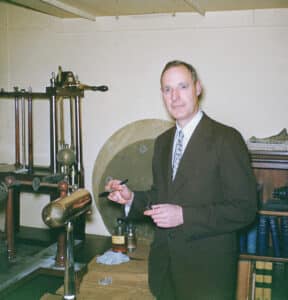
This is a story of the impact a collector can have on creating one of the world’s most celebrated of specialized museums. The museum is Harvard University’s Collection of Historical Scientific Instruments and the man responsible is David P. Wheatland of Topsfield, Massachusetts.
The Collection of Historical Scientific Instruments is one of the finest university collections of its kind in the world. It holds more than 22,000 artifacts dating from the 15th century to the present and spans a broad range of disciplines, including astronomy, physics, biology, chemistry, geology, meteorology, mathematics, medicine, psychology, navigation, horology, surveying, photography, and communications. Many of these scientific instruments were acquired by Harvard for research and teaching starting in the 17th century. Others were the gifts of collectors. The historical value of the instruments is greatly enhanced by original documents preserved in the Harvard University Archives and by over 6,500 books and pamphlets in the collection’s research library that describe the purchase and use of many of the instruments.
The First Great Influencer
The objects in the Collection can be beautiful to gaze upon and reveal exquisite craftsmanship, but these tangible things are more than relics. Not only do they trace the development of scientific activity over 500 years, but they also exhibit the confluence of religion, politics, philosophy, art, and commerce with our understanding of nature and the use of technology. Take for instance the large number of instruments that Harvard purchased in London with the help of Benjamin Franklin after a disastrous fire in 1764 destroyed the College’s philosophical apparatus. Franklin was in London on political business but offered to be Harvard’s “personal shopper.” He must have had a ball going to his favorite instrument makers and spending Harvard’s money. He bought better quality than he could afford for himself. Consequently, Harvard now has more apparatus associated with Franklin than survives in Philadelphia.
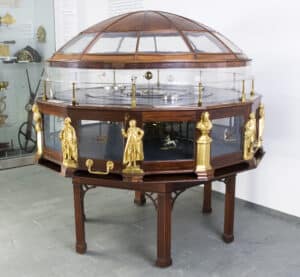
Franklin’s instruments have their own stories to tell. Clocks, quadrants, and telescopes were taken behind British enemy lines to observe rare astronomical events during the American Revolution and surveyed boundaries between the new states. Electrical machines, air pumps, and orreries taught natural philosophy to John Quincy Adams. In the 19th and early 20th centuries, Harvard’s scientists turned to France, Germany, and eventually, the United States to outfit laboratories, the observatory, and lecture halls. Chemicals produced in Paris for the Medical College of Alabama were captured en route during the Civil War and diverted to Harvard. They sit on Harvard shelves still. Close to 100 train wrecks in New England before 1853—when one of the worst head-on collisions at the Boston Switch was blamed on a conductor’s faulty watch and his hubris that he could beat the oncoming train—led railroad superintendents to beseech the Harvard College Observatory to provide time signals for the rails. The Observatory obliged by hooking up its best clock to telegraph lines to tell the time. That clock by William Bond & Sons still runs and is on display. These are but a few of the stories told by a Collection that preserves the research apparatus of Louis Agassiz, Oliver Wendell Holmes, William James, Annie Jump Cannon, Grace Hopper, and B. F. Skinner; and the pedagogical equipment that instructed Henry David Thoreau, W.E.B. Du Bois, Theodore Roosevelt, and Gertrude Stein.
The Next Great Influencer
None of this apparatus would have been preserved, much less assembled in one place, without the stewardship of David Wheatland. David Pingree Wheatland (1898-1993)—known affectionately to many as Mr. Wheatland—began amassing the nucleus of objects that were to become the Collection of Historical Scientific Instruments in the 1920s. After graduating from Harvard College in 1922 with a Bachelor of Science degree, he became involved in his family’s lumber business in Maine. Though successful in business, he remained unfulfilled in this work, and Mr. Wheatland returned to Harvard in 1928 to work in the Physics Department, first as a technical assistant to Professor Leon Chaffee, then as Department Secretary, and in 1940, as the Assistant Director of the Cruft Research Laboratory of Physics. In the latter position, he oversaw the assembly
of the first programmable computer in the United States, the IBM-Harvard Mark I, and became one of its first civilian operators.
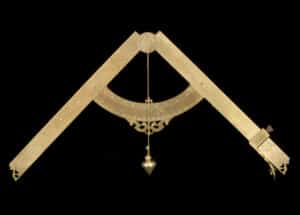
Marc’Antonio Mazzoleni, circa 1604
Inv. #DW0950, Rendition number D008708
Mr. Wheatland’s duties in the Physics Department led to numerous encounters with obsolete instrumentation often discarded in the stairwells and attics of the science buildings on campus. A zealous collector of rare books on electricity and magnetism, Mr. Wheatland recognized what these castoff instruments were from the marvelous engravings in his old books. He understood that these objects represented an important part of the local scientific heritage, but he feared that they were in physical danger due to neglect as well as the propensity of faculty and students to cannibalize them for spare parts. Since the Physics Department did not then see any value in the instruments, Mr. Wheatland took them into his office for safekeeping. Larger items, like the Pope orrery, were stored in the basement of the Music Building.
When his small office became filled to overflowing with “foundlings,” Mr. Wheatland sought a new space for the assemblage. He was assisted in this effort by Paul H. Buck, the Provost of Harvard College, I. Bernard Cohen, then an Assistant Professor of the History of Science, and William A. Jackson, the founding curator of Houghton Library, and Samuel Eliot Morison, the historian. The group gathered together an introductory exhibition of the collection in February 1949, and the following year, the Provost found space in the basement of the Semitic Museum (today known as the Harvard Museum of the Ancient Near East ) to serve as the home of the now officially recognized Collection of Historical Scientific Instruments. Mr. Wheatland was appointed curator and generously agreed to work for $1 per year. He held this post until 1964 when he became
honorary curator.
A Saver of Things
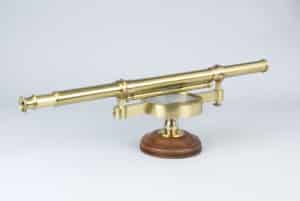
Mr. Wheatland was tireless in watching out for wayward parts of Harvard’s scientific heritage. On a visit to the university’s photographer, he noticed a “nice little brass bubble level” in his photo lab. The photographer confessed that he had picked it up somewhere in the physics labs, and let Mr. Wheatland have it. Over time he recognized that this was part of a surveyor’s level by Benjamin Martin of London. He found the magnetic compass with arms in a case in the Jefferson Laboratory, the
telescope that clamped to the arms in a cabinet of teaching apparatus for Physics B, and the tripod of wood and a brass cap with fittings to set and level the compass in a pile of discarded parts in the attic. This significant brass instrument had arrived at Harvard in 1765 with Franklin’s help and was loaned in 1775 to the Massachusetts militia to survey the line between its encampment and the British position.
Mr. Wheatland made another spectacular find on top of an apparatus cabinet in the laboratory of physicist Kenneth Bainbridge. It was a divided brass circle mounted vertically, which Bainbridge claimed he was saving to make a student spectrograph. It turned out to be a fine dip circle hand-picked by Benjamin Franklin for Harvard at the shop of Edward Nairne in London.
Rescue missions became a regular and legendary part of Mr. Wheatland’s curatorial program. He was often joined in them by his wife Elizabeth (Betty) Hinckley Wheatland, and beginning in the 1960s by Ebenezer Gay, the devoted assistant curator for the Collection. r. Wheatland also began his own private collection of instruments with the idea of supplementing and filling in the gaps in the Harvard Collection. His collection included over 700 sundials and a similar number of dialing books, over 3,000 early vacuum tubes and some of the first transistors, many radios and radar devices, telephone prototypes and meteorological firsts, as well as significant instruments related to the history of astronomy, navigation, surveying, and physics. He had a real knack for knowing what would be of fundamental historical importance long before anyone else thought to save it. These items were stored in a stone house, barn, and Quonset hut dubbed the Radar-Radio Shed on Mr. Wheatland’s farm in Topsfield, MA. Today they are part of the Collection of Historical Scientific Instruments.
The Wheatland Legacy
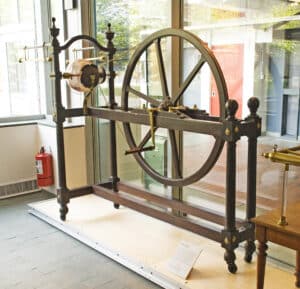
The quality and importance of the Wheatland gift cannot be overstated. Let me single out one example. This is the geometrical and military compass invented by Galileo, made by his personal instrument maker, and given to the Duke of Mantua in 1604. It is one of only three extant examples in the world.
In 1968, Mr. Wheatland published The Apparatus of Science at Harvard, 1765-1800 and by the 1970s, he and Gay were showing off some of the instruments in the annual lectures that Professor Cohen delivered to sophomores concentrating in History and Science. In 1976, I attended one of these lectures and decided to stop by Allston Burr the next week to learn more about the instruments. Apparently, I was the first student to do this. I was thoroughly charmed by the two curators, who invited me to come again. When I returned the following week, I was greeted with “Looks like we have a live one here, Eben!” – “Better sign her up, Mr. Wheat.” And so I became their apprentice.
Mr. Wheatland had a longstanding belief in the value of the Collection as a resource for the understanding of the past and a vision for its use in research and teaching. In this belief and vision, he was way ahead of his time. By the time of his death in 1993, thousands of scientific instruments, books, maker’s catalogs, and manuals had been donated to the Collection of Historical Scientific Instruments and another 4,600 rare imprints had been given to Houghton Library. Even more critically, he ensured the future of the Collection by establishing an endowment, the income from which supports a curator and other operating costs.
Approximately ninety-five percent of the apparatus, books, and other items in the Collection of Historical Scientific Instruments were touched by David P. Wheatland. They were rescued, conserved, documented, and housed, bought, donated, treasured, and shared. Without his vision and unstinting generosity, this Collection would not exist.
Although its free public galleries are presently closed due to the COVID-19 pandemic, visitors may go to our website, chsi.harvard.edu, and explore the online database of the Collection.
Sara J. Schechner, PhD is the David P. Wheatland Curator of the Collection of Historical Scientific Instruments and on the faculty of the History of Science Department, Harvard University.





Related posts: